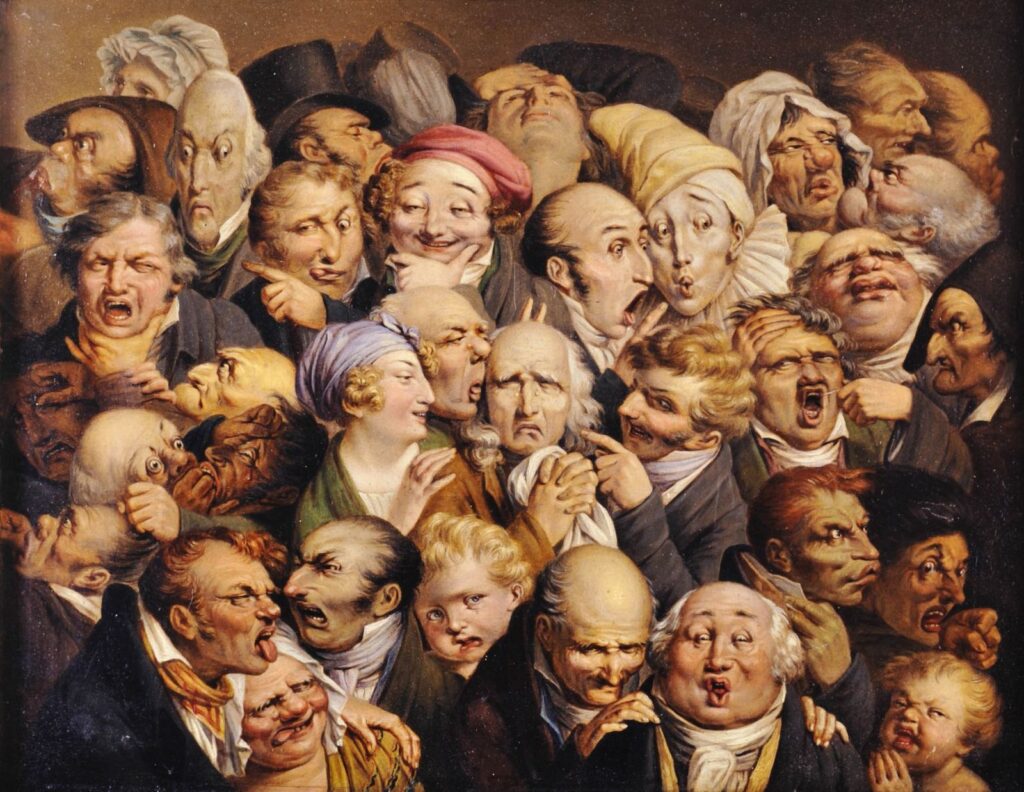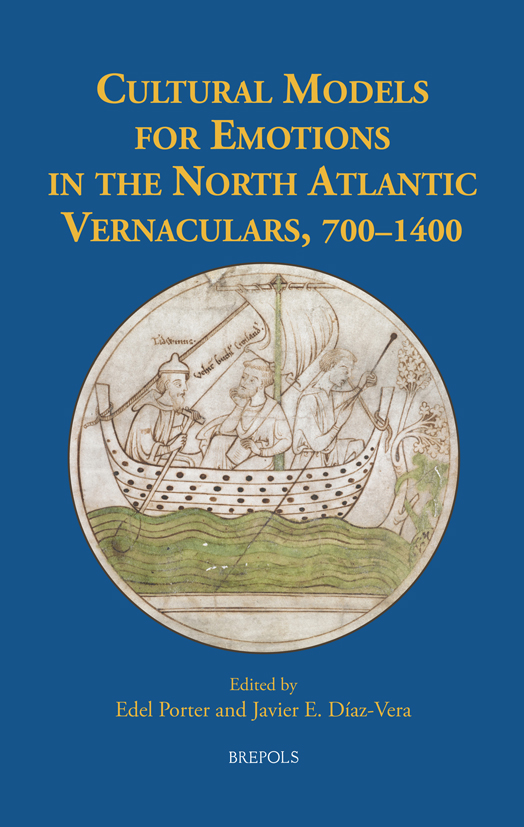Rationale

Cluster IP
Emotions play a profound role in shaping both individual and collective identities, influencing how we see ourselves and how we connect with others. Feelings such as pride, fear, love, and resentment are not just personal experiences—they are powerful forces that shape cultures, influence textual genres, and define group belonging. From national celebrations to moments of crisis, emotions help construct shared narratives that bind communities together.
In this research cluster, we explore how emotional expressions across different contexts reveal the deep connections between affective experiences and identity formation, offering new insights into the ways emotions shape societies across time and space.

The Meeting of Thirty-Five Heads of Expression by Louis-Léopold Boilly (Wikimedia Commons).
Leading research questions
By examining how emotions are expressed and experienced in different contexts, we can better understand their impact on identity formation over time. In this cluster, we aim to explore the intricate relationship between emotions and identity from a historical, cultural, and linguistic perspective.
How do emotional expressions in historical and literary texts reflect and shape collective identities across different cultures and time periods?
What role do emotions play in defining group belonging, reinforcing social hierarchies, and distinguishing between “insiders” and “outsiders” within a community?
How do emotions such as pride, fear, and resentment contribute to narratives of national identity, and how have these narratives evolved in response to historical events?
The melancholy of black slaves forced to labour in America, the emotional self-restraint of the middle classes living in Victorian times, the never-ending love of mothers for their children, or the lack of social empathy of right-wing politicians – these are just a few examples to underpin the notion that social groups (whether defined by class, gender, ethnicity, age, profession, religious denomination, sexual orientation or political preference) often have a distinct emotional identity.
(Dorothee Sturkenboom, 2014, “Understanding emotional identities: The Dutch phlematic temperament as historical case-study.” Low Countries Historical Review 129.2, p. 163)
Showcase study (1): Othering by emotional expressions

junior researcher
Emotions are more than mere personal experiences: they are shaped by culture, power dynamics, and social norms, influencing how we express, interpret, and regulate our feelings within different communities.
Throughout history, certain groups have been othered not just because of who they are, but because of how they feel—or rather, how their emotions are perceived, dismissed, or weaponized. This process, known as emotional othering, turns feelings into a means of exclusion, reinforcing stereotypes and deepening social divides.
Emotional othering has existed for centuries, shaping how different groups are perceived and treated. Historical texts reveal how women were dismissed as overly emotional, making them seem unfit for leadership, while men were expected to suppress emotion to appear strong.
Similarly, entire racial and ethnic groups have been stereotyped based on supposed emotional traits—seen as too passionate, too aggressive, or too stoic—often justifying discrimination. These patterns persist today, influencing everything from workplace dynamics to legal judgments.
Showcase study (2): Emotions at the heart of medieval identities

senior researcher
Exploring emotions in historical texts is key to uncovering medieval identities. Were emotions something that united people, or did they highlight cultural differences? That is one of the things that we need to figure out.
Barbara Rosenwein’s Anger’s Past (1998) gives us a wonderful example of this. In Latin Europe, anger was seen as a sin—but an aristocrat could also use it as a tool for power. Meanwhile, Celtic societies, which did not follow a feudal system, had their own ways of regulating emotions through communal law. One unique practice was saintly cursing, a controlled way to express anger and maintain social order.
Christian Latin traditions did not erase local customs; instead, they blended together and shaped new emotional norms. Scholars point out how poets and legal experts played a big role in keeping these traditions alive. Over time, as Christianity spread, emotions like shame transformed—moving from an honour-based idea to a more internal, guilt-driven feeling.
By studying emotions across medieval texts and textual genres, we get a fascinating look at how these societies handled change, mixed old traditions with new influences, and formed their identities. It is a reminder that emotions have always been a powerful force in shaping cultures—just as they are today.
Major research results
Conference paper
Díaz-Díaz, Gabriela (2025). Success as a cultural mirror: A cognitive sociolinguistic study of metaphor in world Englishes. Language, Thought, and Society: An Exporation of Identities through Cognitive (Socio)linguistics. Thessaloniki, 15-16 March 2025.
RELEVANCE: Metaphor is not just a linguistic tool; it is a fundamental way through which humans conceptualize abstract ideas and navigate cultural identity. This study highlights how different English varieties frame “success” through metaphor, revealing underlying societal values and historical influences. By analyzing metaphorical patterns in British, American, and Nigerian English, we gain insight into how language both reflects and shapes cultural ideologies. Understanding these variations underscores the role of metaphor in shaping thought, reinforcing identity, and negotiating global and local influences in a multilingual world.
KEY AREAS: Conceptual Metaphor, Identity, Sociolinguistics, Success, World Englishes.


Multiauthored volume
Porter, Edel, and Javier E. Díaz-Vera. (2025). Cultural Models for Emotions in the North Atlantic Vernaculars, 700-1400 (Medieval Texts and Cultures of Northern Europe; TCNE 39), Brepols.
ISBN: 9782503610443
RELEVANCE: In this book, we explore the connections among medieval Britain, Ireland, Iceland, and the Scandinavian states, regions that, despite their diversity, shared cultural, historical, and ideological experiences setting them apart from the rest of Europe. The volume examines how these connections shaped shared emotional models and early cross-cultural emotional communities. Drawing on the oldest European vernacular traditions—Celtic, English, and Scandinavian—we trace cultural models for emotions rooted in pre-Christian times.
KEY AREAS: Germanic Languages, Historical Linguistics, Conceptual Metaphor, Cultural Linguistics, History of Emotions.

Book chapter
Porter, Edel (2025). Ship of volition, seabed of desire: Vernacular models of the breast in skaldic diction. In Edel Porter and Javier E. Díaz-Vera (eds) Cultural Models for Emotions in the North Atlantic, 700-1400 (Medieval Texts and Cultures of Northern Europe; TCNE, 38). Brepols.
ISBN: 9782503610443
RELEVANCE: This chapter examines a supposedly tenth-century stanza preserved in the thirteenth-century poetical treatise Skáldskaparmál, arguing that its conceptual model for “breast” exhibits clear signs of originating in the twelfth century or later. While kenning types for “breast” may initially seem stable and consistent throughout the skaldic corpus, this study demonstrates that a closer analysis of context and diction reveals significant variation in their conceptual models between pre- and post-Christian verse. Moreover, it traces their evolution from the ninth to the fourteenth centuries.
KEY AREAS: Old Norse, Conceptual Metaphor, Cultural Linguistics, Kenning, Body-parts, Contrastive Linguistics.

Book chapter
Díaz-Vera, Javier E., and Teodoro Manrique-Antón (2025). SADNESS in Old English and in Old Norse. Extrernalising the Embodied Mind in two North Atlantic Cultures. In Edel Porter and Javier E. Díaz-Vera (eds) Cultural Models for Emotions in the North Atlantic, 700-1400 (Medieval Texts and Cultures of Northern Europe; TCNE, 38). Brepols.
ISBN: 9782503610443
RELEVANCE: In this chapter, we contrast SADNESS in Old English and Old Norse, reconstructing their lexical fields with historical and cognitive linguistic methods. Both languages favour literal expressions, but figurative ones differ: Old English sees sadness as a low-control emotion, while Old Norse links it with anger, framing it as more controllable, often through revenge. We also find differing views of the mind: securely enclosed in Anglo-Saxon texts versus permeable boundaries in Old Norse.
KEY AREAS: Old English, Old Norse, Conceptual Metaphor, Cultural Linguistics, Sadness, Contrastive Linguistics.

Journal article
Díaz-Vera, Javier E. (2025). Negotiating converso identities in the inquisition courtroom: Impoliteness and self-politeness in the 1568-1569 trial of Catarina de Orta. Journal of Historical Pragmatics 26(1): 100–124.
ISSN: 1566-5852
RELEVANCE: In this article, I examine identity construction and negotiation through face work in a Portuguese Inquisition trial, focusing on the case of Catarina de Orta. Analyzing both the inquisitor’s questions and the defendant’s responses, I show how impoliteness and self-politeness coexist in courtroom discourse. The inquisitor uses impoliteness to assert power, provoke negative emotions, and undermine the defendant’s credibility. In contrast, the defendant employs self-politeness to protect her face against these attacks. This interplay shapes the competing narratives of accuser and defendant, evolving with each interrogation.
KEY AREAS: Portuguese, Inquisitions, Jewish Studies, Negative Emotions, Courtroom Discourse, (Im)politeness.



Journal article
Caballero, Rosario, and Javier E. Díaz-Vera (2021). Metaphor variation and change in World Englishes: A corpus-based study of FEAR, HUMILIATION, and HOPE. ESSE Messenger 30(1): 1–21.
ISSN: 2518-3567
RELEVANCE: The study of metaphor variation and change presents unique challenges for systematic linguistic analysis. Recent developments in cognitive sociolinguistic theory emphasize the importance of understanding conceptual differences across linguistic varieties. Our research contributes to this field by using statistical analysis of large dialectal data sets to explore lexical variation and change in World English. We focus on why certain emotion conceptualizations are more common in some varieties. Our findings show that local socio-cultural models of emotions influence lexical variation and change at the dialectal level, highlighting the relevance of socio-cultural contexts in shaping language.
KEY AREAS: Cognitive Sociolinguistics, Emotion Metaphor, Cultural Linguistics, Geopolitics of Emotions, Sociology.



Journal article
Díaz-Vera, Javier E. (2021). Ælfric’s expressions for shame and guilt: A study in intra-writer conceptual variation. Studia Anglica Posnaniensia 56(1): 39–53.
ISSN: 0081-6272
RELEVANCE: This research analyzes onomasiological variation in Old English texts by Ælfric, focusing on how shame and guilt are expressed across genres. By examining all relevant expressions in the Ælfrician corpus, we propose a network of literal and figurative conceptualizations for these emotions. Our analysis reveals the tension between literal, metonymic, and metaphoric expressions. We show that the introduction of Augustinian psychology in Anglo-Saxon England led to (i) the decline of the Germanic view of shame and guilt as social control tools, (ii) the spread of new values, and (iii) the rise of embodied metaphors like SHAME IS A COVER and GUILT IS A BURDEN, reflecting a shift toward self-directed emotional evaluation in line with Christianization.
KEY AREAS: Old English, Conceptual Variation, Intra-writer Variation, Shame, Guilt.



Book chapter
Díaz-Vera, Javier E. and Teodoro Manrique-Antón (2015). ‘Better shamed before one than shamed before all’: Shaping shame in Old English and Old Norse texts. In Javier E. Díaz-Vera (2015) Metaphor and metonymy across time and cultures: Perspectives on the sociohistorical linguistics of figurative language. De Gruyter Mouton, 225–264.
ISBN: 978-3110335453
RELEVANCE: In this chapter, we analyze the evolution of the concept of shame in two distinct Germanic languages: Old English and Old Norse. Our primary goal is to trace the gradual transition from a shame-based society, where public humiliation functions as a tool for social control, to a guilt-based society, where personal recognition of wrongdoing and fear of divine punishment are central. This shift reflects a broader cultural change from collective to individual emotional experiences, which had profound implications for the linguistic expression of shame. Through the analysis of literal, metonymic, and metaphorical expressions of shame in our corpora of Old English and Old Norse texts, we aim to demonstrate how these languages reflect the evolving societal attitudes towards shame, highlighting the progressive individualization of this emotion in both cultures.
KEY AREAS: Old English, Old Norse, Metaphors, Shame, Cognition, Germanic Linguistics.



Journal article
Díaz-Vera, Javier E. (2014). Emotions in the household: Emotion words and metaphors in ‘Domesday Book’ personal names. Names: A Journal of Onomastics 62(3): 165–176.
ISSN: 0027-7738
RELEVANCE: This research sheds light on the cultural significance of emotions in late Old English society through an analysis of emotion-related personal names recorded in the Domesday Book. By examining naming practices, including gender distribution and lexical combinations of emotion themes, the study reveals insights into societal values, emotional metaphors, and the evolution of language in post-Conquest England.
KEY AREAS: Old English, Name-giving, History of Emotions, Gender, Domesday Book.



Journal article
Díaz-Vera, Javier E., and Rosario Caballero (2013). Exploring the feeling-emotions continuum across cultures: Jealousy in English and Spanish. Intercultural Pragmatics 10(2): 265–294.
ISSN: 1613-365X
RELEVANCE: In this article, we analyze metaphorical expressions of jealousy in American English and Peninsular Spanish. Using the Corpus of Contemporary American English and the Corpus de Referencia del Español, we examined occurrences of jealousy and celo(s) (and their derivatives) to identify metaphorical source domains for this emotion. These domains were grouped and compared both quantitatively and qualitatively across the two languages, with a focus on the role of sensory perception in shaping metaphors of jealousy. Our findings highlight the centrality of touch in both languages, alongside a broader variety of sensory-related metaphors in American English.
KEY AREAS: American English, Spanish Jealousy, Sensory Perception, Comparative Linguistics, Metaphor.



m
m
Funding received
Languages, Emotions, and Identities in the History of Europe: Application to the Development of a Collective Identity as an Instrument of European Integration (2022-GRIN-34448), funded by FEDER-EU/UCLM
This project (2022-2025) examines the concept, challenges, and perspectives of collective identity within the context of European integration. From a linguistic and cultural standpoint, it explores how emotional conceptualizations have evolved throughout European history, with the aim of understanding how a deeper knowledge of our affective history can help address the current challenges of collective identity. Emotions reveal who we are, and in times of uncertainty and identity crises, many turn to them as a guide. In the political sphere, European integration has emphasized the need for a common identity, yet most studies focus on European values, overlooking the emotional dimension.
This project proposes that Europe has been shaped by interconnected emotional communities over centuries. Through the study of its linguistic and cultural history, it aims to show how this collective identity is rooted in a shared affective history. Furthermore, the project seeks to apply this knowledge to the European integration process, incorporating an emotional aspect that acknowledges and strengthens the concept of shared identity within the community.
FELICE: Feeling Europe; Languages, Identities, and Collective Emotions in the European Union (Erasmus+ Project 608747-EPP-1-ES-EPPJMO-CHAIR), funded by the European Commision
This Jean Monnet Chair has been developed with the main aim of introducing students with a relatively limited knowledge of European institutions to a series of important EU-issues (related not only to language policies and planning, but also to human rights, social inclusion, etc). This module adopts an interdisciplinary approach to the study of EU language policies, with a particular focus on language legislation, sociolinguistics, language education and linguistic ethnography.
Our activities cover the EU’s institutional framework and key decision-making processes, the main theoretical perspectives on European language policies and an analysis of core fields of multilingualism within a EU perspective. The module is aimed at students from such areas as Linguistics, Cultural Studies and Education, who seek to engage in EU-related research and/or would like to work in or with EU institutions in their professional careers. The activities provide students with an advanced-level overview of language policies in the European Union and introduces them to contemporary challenges of European multilingualism.